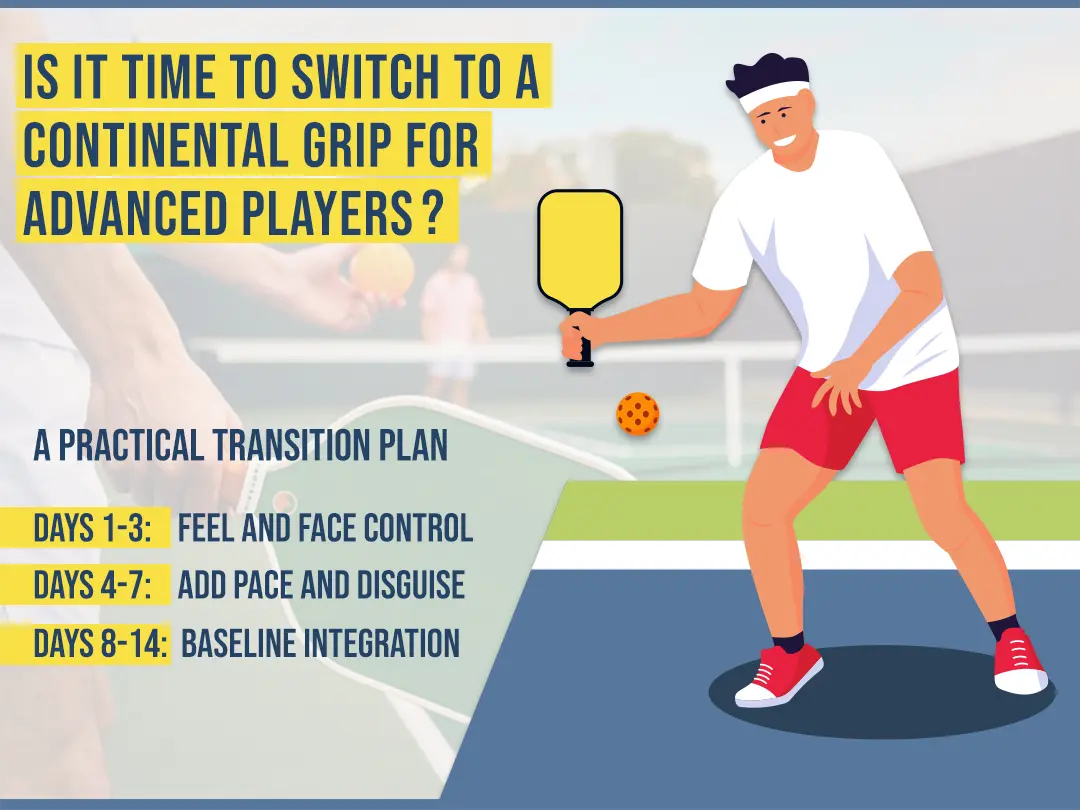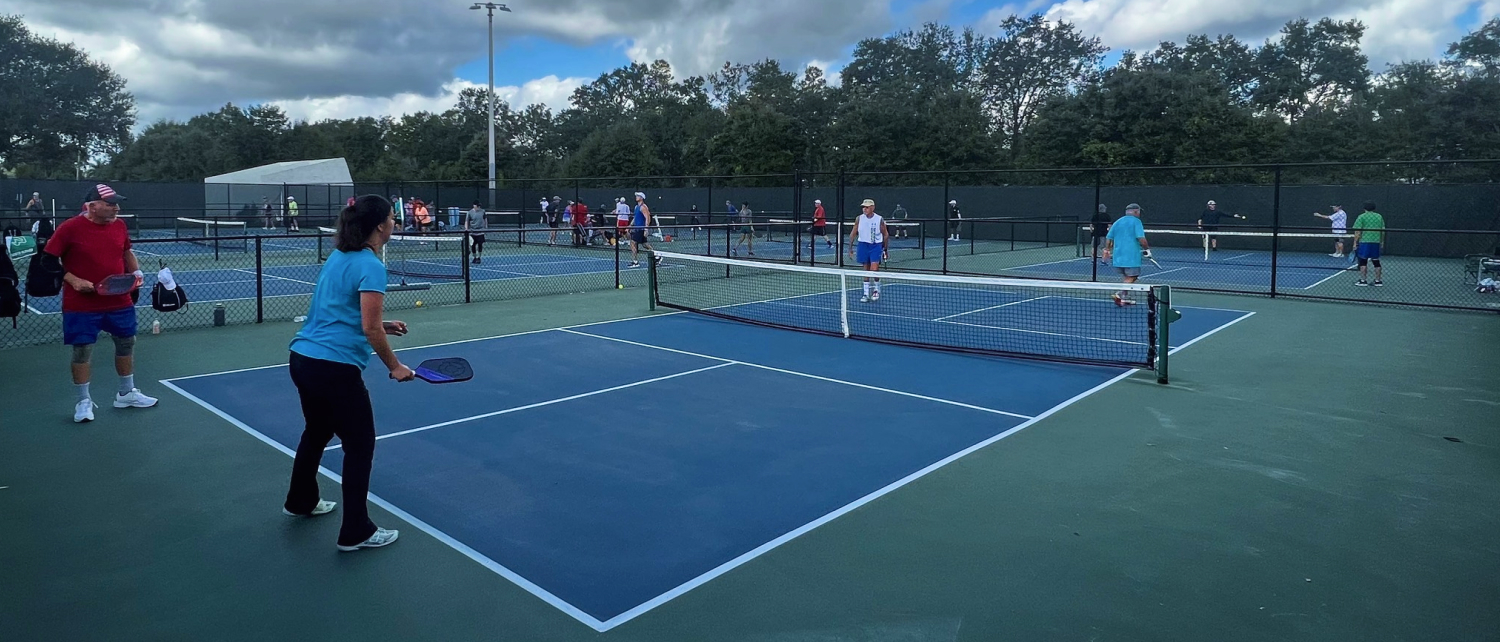Your cart is currently empty!

If you are pushing into advanced play, your grip choices will either unlock your best shots or quietly hold you back. Many intermediate players build confidence at the baseline with an eastern or even semi-western forehand grip. The ball feels lively, drives jump off the paddle, and topspin comes easier. The problem begins when that same grip follows you to the non-volley zone. At the kitchen, a forehand-biased grip can force awkward mechanics on the one-handed backhand, which leads to pop-ups, attackable balls, and lost points.
Make continental your go-to. Use it at the kitchen and for most baseline work, including serves, returns, third shots, and counters. For a full overview of grip families and where they shine, see our guide to pickleball grips.
Why Intermediates Lean Eastern or Semi-Western
Eastern and semi-western forehand grips reward a windshield-wiper path with easy topspin and a strong contact on shoulder-high balls. From the baseline, this feels great on drives, roll volleys, and higher third shots. Many players ride that success straight into the kitchen without a plan to adjust. The result is a forehand face that wants to close and a backhand face that feels late or unstable.
The Kitchen Problem With a One-Handed Backhand
At the non-volley zone, you must neutralize pace, keep the ball below net height, and change directions quickly. A forehand-biased grip betrays you in three ways.
1) Closed face on the forehand dink. The paddle wants to point down. Unless your wrist and forearm angle are precise, the ball leaves low, flattens out, and drifts high after the bounce.
2) Weak, late backhand block. With an eastern forehand in your hand, it takes time to turn the face open on a one-handed backhand. That delay creates a soft, high block that sits up, or a jab that sprays long.
3) Poor disguise on counters. When your grip is not neutral, your forehand and backhand swing paths look different. Advanced opponents read your intentions earlier, which invites them to speed up first or sit on your lanes.
These issues cause the most common kitchen miss for one-handed players: the pop-up. The ball rides above net height, and your opponent ends the rally.
Why a Continental Default Works
A continental grip places the paddle face in a neutral orientation. That neutrality delivers immediate advantages.
– Faster forehand-to-backhand transitions. You can block, stab, or counter on either wing without a grip change.
– Stable resets. A square, slightly open face helps you absorb pace and send the ball soft and short.
– Cleaner dinks. The forearm stays quieter, and the wrist works like a hinge rather than a lever. You lift underspin without scooping.
– Better disguise. The same setup supports a soft dink, a quick roll, or a punch counter, which keeps opponents guessing.
All-Continental From the Baseline: Does It Hold Up?
You may worry that continental weakens your serve, return, and drives. It does change the feel. Topspin requires a bit more forearm and a slightly higher contact. For many advanced players, the tradeoff is worth it because the overall system becomes simpler. Third shots blend into transition resets, which blend into kitchen exchanges, all with the same hand position. You reduce grip-change errors, improve hand speed, and keep a single contact picture under pressure.
If you love your heavy forehand roll, consider a modified continental that leans a half bevel toward eastern. You retain neutrality at the kitchen while picking up more forehand leverage for baseline offense.
A Practical Transition Plan
You do not need to overhaul your game overnight. Use this two-week progression to adopt continental as your default.
Days 1-3: Feel and face control.
– Wall volleys, forehand to backhand, 100 contacts without a grip change.
– Forehand and backhand dinks crosscourt with a quiet wrist hinge.
– Reset drill from mid-court: partner feeds at your chest and hips. Aim for soft landings near the kitchen line.
Days 4-7: Add pace and disguise.
– Punch-block counters from five feet off the kitchen.
– Dink, dink, speed-up, block sequences. Same grip, three tempos.
– Third-shot drops with continental. Start shoulder-high, then knee-high.
Days 8-14: Baseline integration.
– Serve and return with continental. Emphasize height over the net, depth to the feet, and a taller posture.
– Drive with shape rather than pure flat pace. Find a ball height that lets you cover the next shot with the same grip.
– Transition live points where you are not allowed to change grips until you establish at the kitchen.
Common Objections and Fixes
– My forehand roll lost bite. Use a slightly higher contact and finish palm-forward. Add a half bevel toward eastern if needed.
– My overhead feels weaker. Load with your legs and rotate your torso. Continental supports a square face and better placement.
– My resets float. Check paddle path. With continental, think lift and catch, not swing and push.
When to Keep Two Grips
If your two-handed backhand is a major weapon, you may still change to an eastern forehand for certain drives and overheads. The key is to start neutral at the kitchen and only change when you have time and a clear reason. The default should support defense, disguise, and fast exchanges, which is exactly what continental provides.
The Bottom Line
Intermediate habits built around an eastern or semi-western forehand can stall your growth at the kitchen, especially if you rely on a one-handed backhand. A continental default simplifies your decision making, stabilizes your blocks and resets, and improves disguise. For many advancing players, it is worth adopting continental across phases of play, including serve, return, and selected drives. Start with the progression above, then refine based on your strengths. For more detail on how each grip behaves by shot type, revisit our guide to pickleball grips and build a plan that matches your goals.






